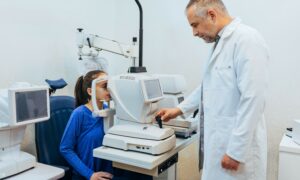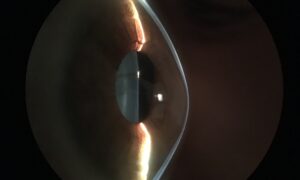July 1, 2024
By Nicole Liu, MOptm, PhD Candidate, Brien Holden Vision Institute
Melatonin is an ancient molecule that originated as a free radical scavenger and evolved in bacteria, later becoming integral to eukaryotic life through symbiotic associations.1 In humans, melatonin is primarily produced by the pineal gland in response to the light-dark cycle, regulating sleep, circadian rhythms, immunity, and oxidative stress.2 Its secretion peaks at night and varies with seasons, reflecting photoperiod changes and influencing biological and behavioral functions, with levels highest in early childhood and decreasing with age.3,4 Positive effects of melatonin and its analogs in treating various ocular conditions such as dry eye and cataract have been frequently reported in studies using animal models.5-8 In humans, melatonin and its analogs also demonstrated beneficial impact in lowering intraocular pressure, treating glaucoma, and improving age-related macular degeneration.9
Interest in the role of melatonin in myopia has been growing recently, yet findings are inconsistent.10 Thus, Hussain et al.11 conducted a systematic review critically summarizing and analyzing current literature on systemic levels of melatonin and myopia, aiming to enhance our understanding of this relationship.
Seven cross-sectional studies published between January 2010 and December 2022 were reviewed, including sample sizes ranging from 18 to 120 participants aged between 5 and 41 years. Two studies examined serum melatonin, three examined saliva, and two examined both saliva and urine or serum. Various analytical methods were employed, including liquid chromatography-mass spectrometry, enzyme-linked immunosorbent assay, and double antibody radioimmunoassay. Results are conflicting: three studies reported elevated melatonin concentrations in myopes,12-14 one study noted a significantly lower overnight urinary melatonin output and delayed melatonin circadian timing in myopes compared to emmetropes.15 In contrast, other studies found no difference in the timing/phase or concentration between refractive groups.13,16,17
The authors concluded that future studies with larger cohorts, robust methodological approaches, longitudinal designs, and standardized methodologies are essential to elucidate melatonin’s potential role in myopia development.
Abstract
Associations Between Systemic Melatonin and Human Myopia: A Systematic Review
Azfira Hussain, Aparna Gopalakrishnan, Hannah Scott, Chris Seby, Victoria Tang, Lisa Ostrin, Ranjay Chakraborty
Purpose: Experimental models have implicated the role of melatonin circadian rhythm disruption in refractive error development. Recent studies have examined melatonin concentration and its diurnal patterns on refractive error with equivocal results. This systematic review aimed to summarize the literature on melatonin circadian rhythms in myopia.
Recent findings: PubMed, EMBASE, Web of Science, Scopus, ProQuest Central, LILACS, Cochrane, and Medline databases were searched for papers between January 2010 and December 2022 using defined search terms. Seven studies measured melatonin and circadian rhythms in three biological fluids (blood serum, saliva, and urine) in both myopes and non-myopes. Morning melatonin concentrations derived from blood serum varied significantly between studies in individuals aged 10-30 years, with a maximum of 89.45 pg/mL and a minimum of 5.43 pg/mL using liquid chromatography and mass spectrometry. The diurnal variation of salivary melatonin was not significantly different between myopes and emmetropes when measured every 4 h for 24 h and quantified with enzyme-linked immunosorbent assay. Significantly elevated salivary melatonin concentrations were reported in myopes compared with emmetropes aged 18-30 years when measured hourly from evening until their habitual bedtime using liquid chromatography. However, the relationship between dim light melatonin onset and refractive group was inconsistent between studies. The 6-sulphatoxymelatonin concentration derived from overnight urine volume, measured using a double antibody radioimmunoassay, was found to be significantly lower in myopes (29.17 pg/mL) than emmetropes (42.51 pg/mL).
Summary: The role of melatonin concentration and rhythm in myopia has not been studied extensively. This systematic review confirms conflicting findings across studies, with potential relationships existing. Future studies with uniform methodological approaches are required to ascertain the causal relationship between melatonin dysregulation and myopia in humans.
Hussain, A., Gopalakrishnan, A., Scott, H., Seby, C., Tang, V., Ostrin, L., & Chakraborty, R. (2023). Associations between systemic melatonin and human myopia: a systematic review. Ophthalmic and Physiological Optics, 43(6), 1478-1490.
DOI:https://doi.org/10.1111/opo.13214
References
- Zhao D, Yu Y, Shen Y, et al. Melatonin Synthesis and Function: Evolutionary History in Animals and Plants. Front Endocrinol (Lausanne). 2019;10:249. doi:10.3389/fendo.2019.00249
- Claustrat B, Leston J. Melatonin: Physiological effects in humans. Neurochirurgie. Apr-Jun 2015;61(2-3):77-84. doi:10.1016/j.neuchi.2015.03.002
- Waldhauser F, Steger H. Changes in melatonin secretion with age and pubescence. J Neural Transm Suppl. 1986;21:183-97.
- Scholtens RM, van Munster BC, van Kempen MF, de Rooij SE. Physiological melatonin levels in healthy older people: A systematic review. J Psychosom Res. Jul 2016;86:20-7. doi:10.1016/j.jpsychores.2016.05.005
- Navarro Gil FJ, Huete-Toral F, Crooke A, Dominguez Godinez CO, Carracedo G, Pintor J. Effect of Melatonin and Its Analogs on Tear Secretion. J Pharmacol Exp Ther. Oct 2019;371(1):186-190. doi:10.1124/jpet.119.259192
- Hoyle CH, Peral A, Pintor J. Melatonin potentiates tear secretion induced by diadenosine tetraphosphate in the rabbit. Eur J Pharmacol. Dec 15 2006;552(1-3):159-61. doi:10.1016/j.ejphar.2006.09.012
- Abe M, Reiter RJ, Orhii PB, Hara M, Poeggeler B. Inhibitory effect of melatonin on cataract formation in newborn rats: evidence for an antioxidative role for melatonin. J Pineal Res. Sep 1994;17(2):94-100. doi:10.1111/j.1600-079x.1994.tb00119.x
- Yagci R, Aydin B, Erdurmus M, et al. Use of melatonin to prevent selenite-induced cataract formation in rat eyes. Curr Eye Res. Oct 2006;31(10):845-50. doi:10.1080/02713680600899663
- Martínez-Águila A, Martín-Gil A, Carpena-Torres C, Pastrana C, Carracedo G. Influence of Circadian Rhythm in the Eye: Significance of Melatonin in Glaucoma. Biomolecules. Feb 24 2021;11(3)doi:10.3390/biom11030340
- Ostrin LA. Ocular and systemic melatonin and the influence of light exposure. Clinical and Experimental Optometry. 2019;102(2):99-108. doi:10.1111/cxo.12824
- Hussain A, Gopalakrishnan A, Scott H, et al. Associations between systemic melatonin and human myopia: A systematic review. Ophthalmic Physiol Opt. Aug 11 2023;doi:10.1111/opo.13214
- Kearney S, O’Donoghue L, Pourshahidi LK, Cobice D, Saunders KJ. Myopes have significantly higher serum melatonin concentrations than non-myopes. Article. Ophthalmic and Physiological Optics. 2017;37(5):557-567. doi:10.1111/opo.12396
- Flanagan SC, Cobice D, Richardson P, Sittlington JJ, Saunders KJ. Elevated Melatonin Levels Found in Young Myopic Adults Are Not Attributable to a Shift in Circadian Phase. Invest Ophthalmol Vis Sci. Jul 1 2020;61(8):45. doi:10.1167/iovs.61.8.45
- Kumar S, Gupta N, Velpandian T, et al. Myopia, Melatonin and Conjunctival Ultraviolet Autofluorescence: A Comparative Cross-sectional Study in Indian Myopes. Curr Eye Res. Oct 2021;46(10):1474-1481. doi:10.1080/02713683.2021.1894580
- Chakraborty R, Micic G, Thorley L, et al. Myopia, or near-sightedness, is associated with delayed melatonin circadian timing and lower melatonin output in young adult humans. Sleep. Mar 12 2021;44(3)doi:10.1093/sleep/zsaa208
- Abbott KS, Queener HM, Ostrin LA. The ipRGC-Driven Pupil Response with Light Exposure, Refractive Error, and Sleep. Optom Vis Sci. Apr 2018;95(4):323-331. doi:10.1097/opx.0000000000001198
- Burfield HJ, Carkeet A, Ostrin LA. Ocular and Systemic Diurnal Rhythms in Emmetropic and Myopic Adults. Invest Ophthalmol Vis Sci. May 1 2019;60(6):2237-2247. doi:10.1167/iovs.19-26711















